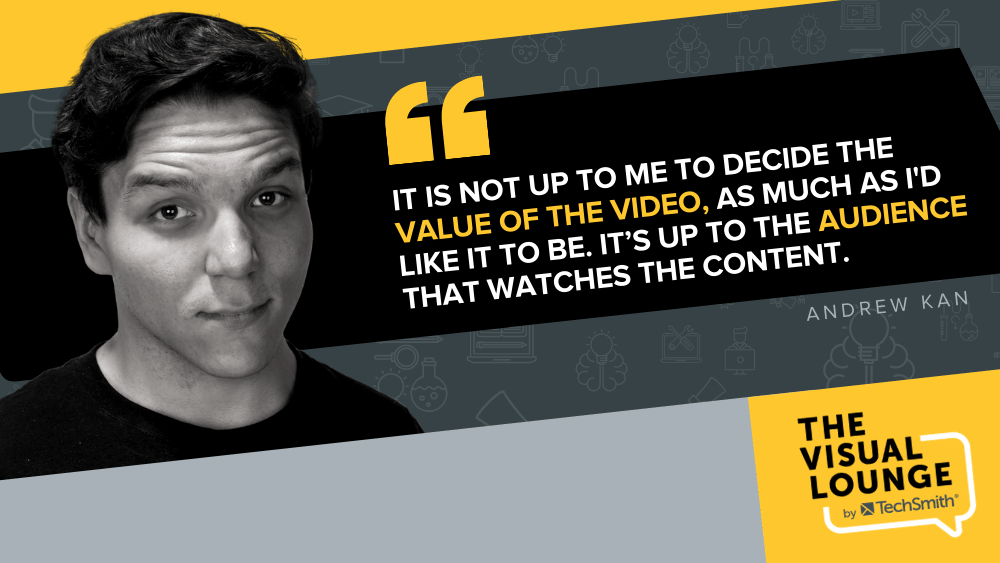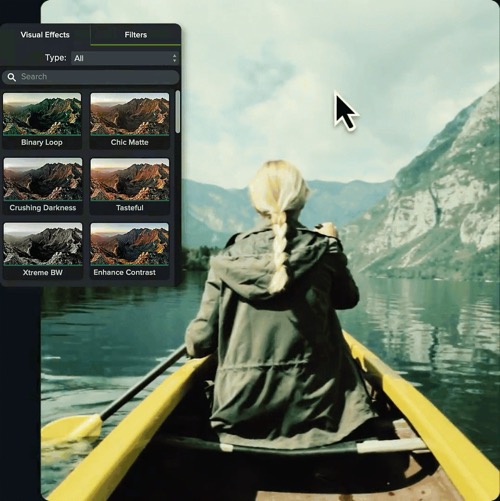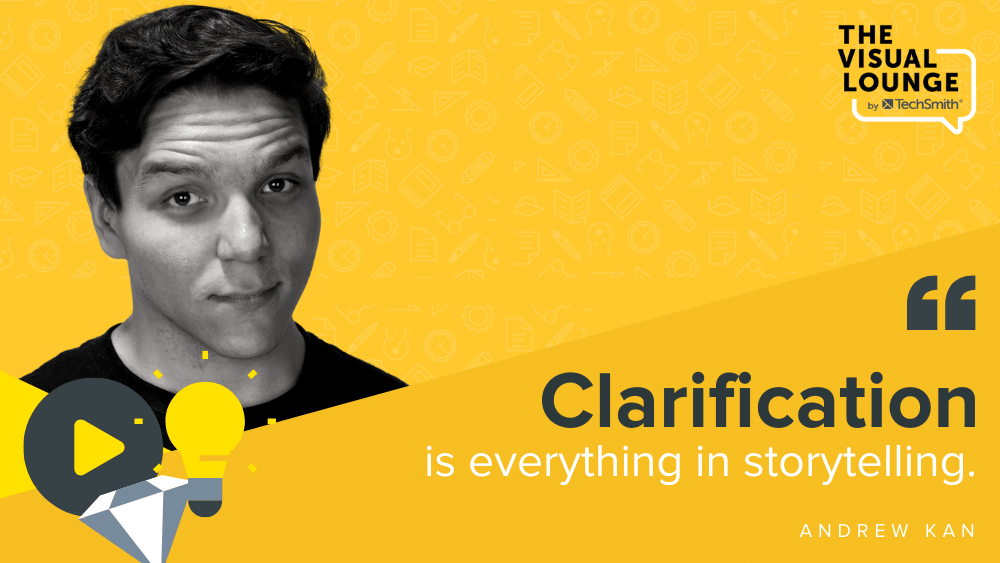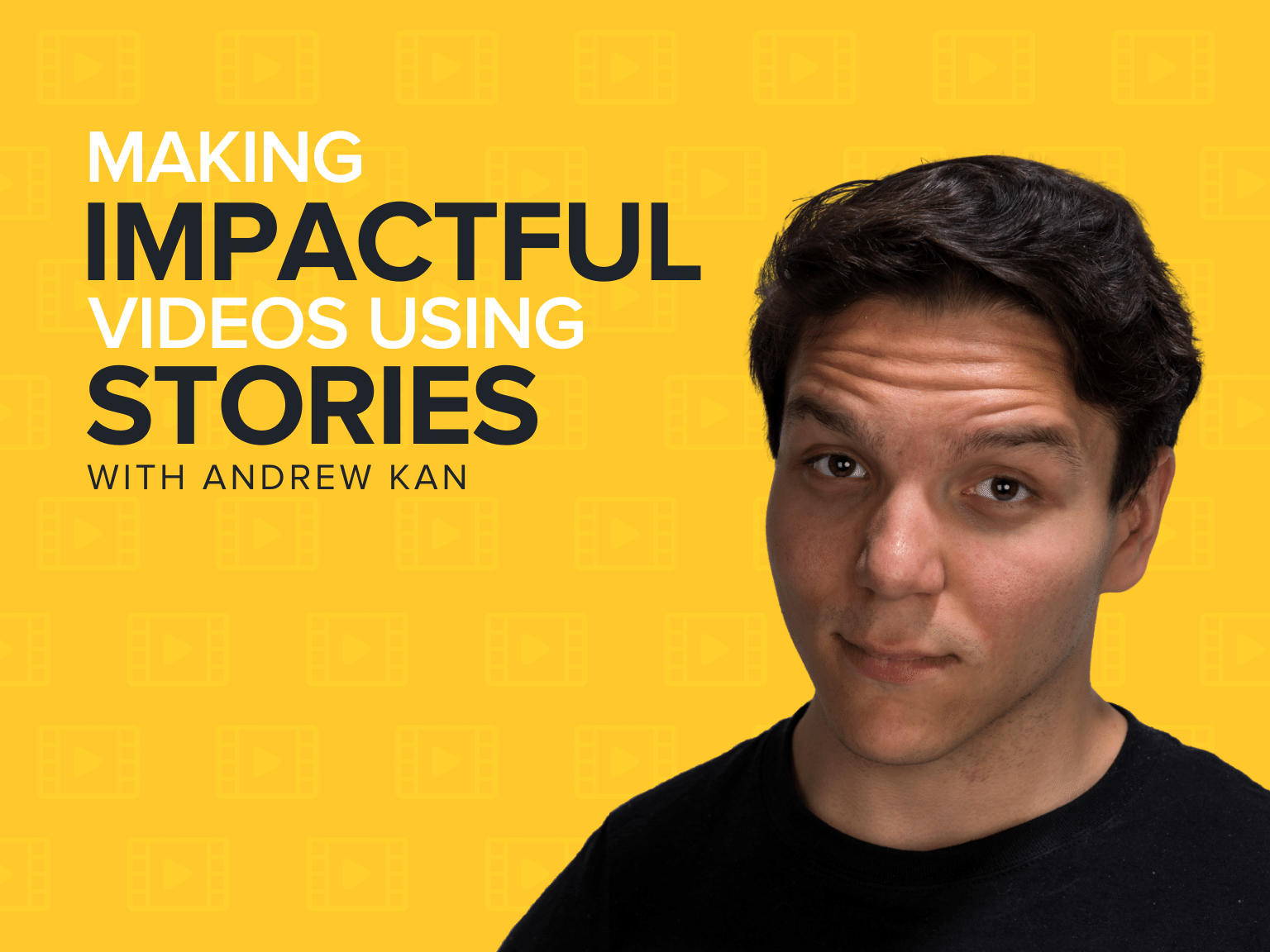Using stories to make more impactful videos is not a new idea. But it’s an overlooked part of video creation, especially when it comes to tutorials or corporate videos.
But storytelling isn’t just for the fun, creative videos out there. Even if you’re creating a video tutorial about car insurance, injecting a little storytelling can go a long way in hitting your primary video goal – connecting with your audience.
Andrew Kan, filmmaker, storyteller, and YouTube creator, joined The Visual Lounge to talk all about story, and how it can help you level up your video skills.
Andrew helps people overcome the hurdles stopping people from achieving their creative goals. He’s an experienced film director and has produced award-winning documentaries for film festivals.
Andrew is skilled in storytelling, YouTube search engine optimization, camera operation, and all things filmmaking. You may know him from his time as Director of Video Production at TubeBuddy, where he used his skills to grow TubeBuddy’s YouTube channel from 6,000 to 525,000 subscribers. This episode has plenty of nuggets of wisdom from Andrew that can benefit all sorts of content creators.
You can watch the video on this topic at the top of this post, to listen to the podcast episode, hit play below, or read on for more…
Creating videos for yourself vs. a corporation
There’s no doubt about it, creating videos for yourself and creating them for a big brand or corporation can feel very different.
But at the end of the day, Andrew says the goals are the same for each type of video – to make a connection with the viewer. Maybe a personal video gives you more creative freedom, but it still needs to connect just like a corporate video does.
“What I found over the years is that both sides are just trying to connect in different ways and that it comes down to the resources available to them. It comes down to whatever message they’re trying to say.”
Why telling a story in your videos can be tough
For Andrew, the biggest challenge he faces when telling stories is that people generally undervalue storytelling. A lot of people will just see a tutorial, but when you think about it, there’s a story in there. You just have to dig it out.
Think about it this way. You have a solution to a problem someone has. That person may be searching for a solution for ages and finally find it in your video.
If you look at storytelling in books or cinema, it all starts with a problem that the hero has to solve. In video creation, you can be the hero, or your company can be the hero, and your tutorial video can be the solution.
As a movie lover, Andrew naturally likes to use movie examples – it’s Star Wars in this case. According to Andrew, a lot of people creating tutorials will envision themselves as Luke Skywalker when really, they’re Obi-Wan Kenobi. He says picture yourself as Obi-Wan helping Luke when you make a tutorial.
Andrew also shares an example of a video he made with a simple story. His video was about how to fill sandbags. Not exactly an epic space adventure.
The problem he wanted to solve was that sandbags cost around $30 if you buy them ready-made. But you can make four of your own for the same price – a simple solution to save money.
It may not win an Oscar any day soon, but it was valuable. It helped the audience overcome an obstacle, and that is the bare bones of storytelling.

How to improve your video skills and storytelling
Andrew has some simple advice for anyone trying to hone their skills. He says, “listen and watch what interests you.”
Find content that resonates with you and start dissecting it. What’s useful about this content? What’s keeping you watching?
It’s hard to look at successful content creators and imagine that they were once in your shoes, scratching their heads and wondering what to do. Most of the time, they did the above. They learned what worked for other people.
“If you are trying to get better at telling stories, watch people who are telling stories and think, what are they doing that’s drawing you in?”
Another piece of advice from Andrew is to stop overthinking storytelling. It doesn’t have to be a huge life-changing thing. Your story can be tiny but valuable.
“When I focus on a story, the first thing I had to do is remember small stories still matter. Stop getting in your own head about it like it has to be this amazing, huge thing because you’re not going to get to that huge story until you tell those little stories first.”
Record professional videos with Camtasia
Camtasia’s features make video recording and editing super easy
Download Free Trial
Don’t sweat about the video gear
A big stumbling block for people creating videos is they worry their gear isn’t good enough. The truth is you don’t need a fancy DSLR camera to get started. Many of us have cameras in our pockets more powerful than cameras used to make Oscar-winning films.
In fact, a common mistake is buying an expensive camera and believing it will fix all your issues. Your video quality won’t change much unless you address the lighting and audio as well.
If Andrew had to prioritize gear to invest in, he’d start with audio. Poor video quality can be forgiven. Bad audio is enough to make people stop watching fast.
“They say “lights, camera, action” because lights go on before you even start the camera. If I were to update it, I’d probably say “mics, lights, camera, action,” just because you want to make sure you’re recording audio first.”

How to grow on YouTube
One of the most popular questions Andrew’s asked is how to grow on YouTube. His advice is to take a step back and figure out what you want to grow in.
For YouTube, he says the most important thing is to start studying the platform. Not just the technical stuff about how it all works, but also studying the audience and how people behave on that platform.
“You would never build a house without a blueprint. But so many times, people will start a YouTube channel without that blueprint.”
Andrew suggests two ways to start studying the platform.
- Figure out what’s working. What does your audience need? What are people in your industry searching for?
- Learn where your audience is coming from. Look at traffic sources, impressions, clickthrough rates. If you’re getting impressions, good! It means YouTube is working. If you’re getting impressions and no views, then it’s because your title and/or thumbnail aren’t working.
“I was getting so many impressions, but the reality was I wasn’t convincing people to click, and that goes down to the storytelling of the thumbnail.”
Focus on watch time
If there’s one stat you need to look at to understand your potential as a creator, it’s watch time. A lot of people don’t really realize how important this is. They take it for granted but just think about it. These people are spending time in their day on your videos. In that moment, you’re connecting with that person and offering them value.
“We often forget that most of the time people are watching, it’s a one-on-one experience. We’re connected with that person in a real way in that moment. And it doesn’t have to be something that makes them cry or be happy. It could just be, ‘you saved me, I was stuck, and I couldn’t figure this out.’ That gratitude is real.”
How to keep people watching
When it comes to keeping people glued to your videos, it depends on the type of story you’re telling. But more importantly, it’s about the value you’re providing.
A story can help keep people interested or entertained, but they need to get value out of it. One mistake people make is adding things that they like rather than thinking about what the audience wants.
Where some people undervalue storytelling, some creators go the exact opposite way. They think the more story, more personality, and more fancy camera setups, the better. But none of that makes a difference unless the audience is getting what they need.
Think about the most interesting way you can deliver valuable information to your viewer while also having fun and being creative with it.
“People were watching longer because I was finding creative ways in the medium I chose to tell the story I wanted.”
Andrew’s take-home storytelling message is to ask yourself: am I trying too much to be in the story rather than telling the story?
For more fantastic video creation, storytelling, and camera tips, listen to the full episode of The Visual Lounge at the top of this page. Or check out TechSmith Academy, where you’ll find all the resources you need to improve your videos.
Record professional videos with Camtasia
Camtasia’s features make video recording and editing super easy
Download Free Trial



Share